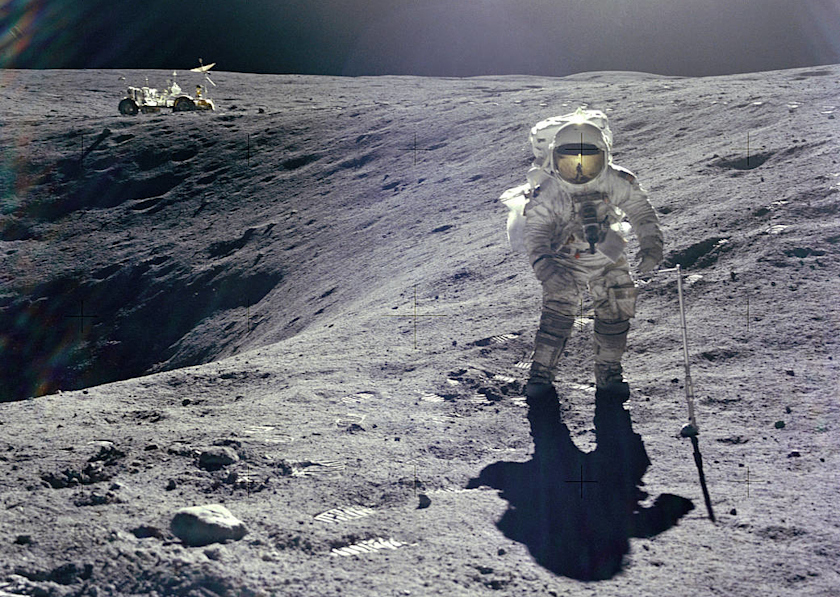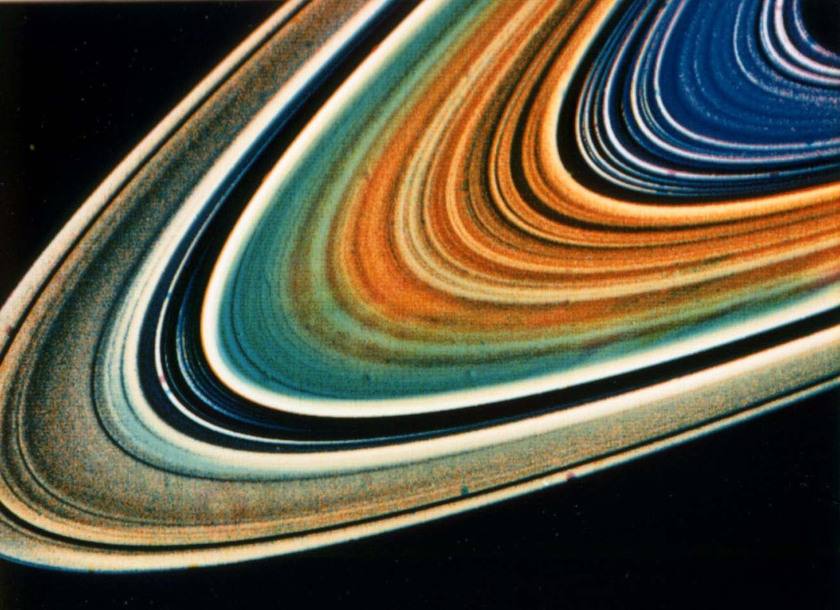Star Dust and Lunar Buggies. An Interview with Charlie Duke, the 10th Man on the Moon
Picture: John Young/NASA (used by permission)
This Saturday July 20, 2019 marks the 50th anniversary of humankind’s first step on the moon. Only twelve people in history have set foot on that bright grey satellite we gaze at each night. Charlie Duke was the tenth. In this fascinating interview (one of my favourites), you’ll hear him describe the experience in gripping detail.
All up, Charlie Duke took part in four Apollo moon missions. He was capsule communicator for the Apollo 11 mission—it’s his voice you can hear giving fuel updates to Neil Armstrong in those now famous recordings of that first moon visit. Charlie was one of the backup crew in the Apollo 13 and 17 flights and, most significantly, on April 20, 1972 he and colleague John Young spent three days walking and driving on the moon’s surface as part of Apollo 16.
What is it like to be strapped into a violently shaking projectile that blasts you into space, with myriad possibilities of you dying in the process? What’s it like riding lunar buggies and playing ‘Moon Olympics’ on that powdery surface? Charlie’s description is vivid. It’s just a shame he left his boots up there.
Listen Now
Podcast: Subscribe in iTunes or Stitcher | Right-click to download | Other episodes
Quick Announcements
- I will be doing a short speaking trip to the United States in October, talking about The Making of Us and other topics. Please contact me soon if you’re interested in having me speak at your church or event
- I will be speaking on Turning Broken Dreams into New Beginnings at New Wine United, Friday August 9. Tickets are sold out but if you’re there come and say hello!
- Small groups in England, Scotland, America and Australia are using The Making of Us as their curriculum. Get your Leader’s Guide and personalised welcome video now and join them!
Shortened Transcript
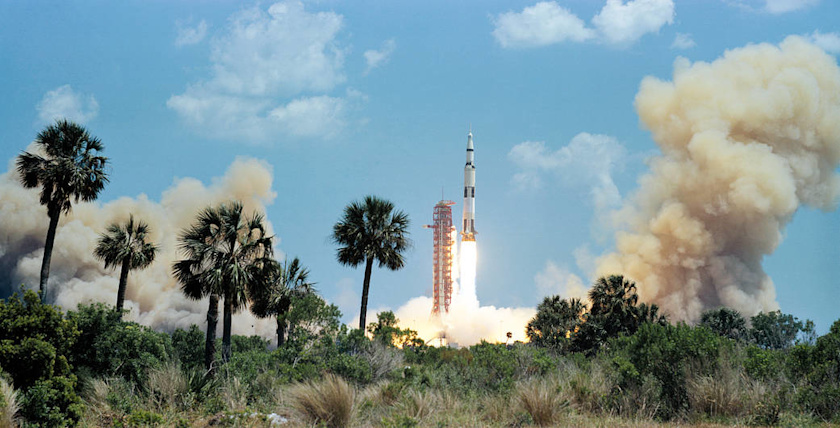
Picture: NASA (used by permission)
This is an edited transcript. The full text is published in Open House Volume 2
So you’re sitting in a massive rocket and you start hearing the 10-9-8 count down start from Mission Control. Describe the emotions. How did you feel at that moment?
Well, you’re ready to go. We had been 2 years in training, and I’m telling you, I was ready to go. I wasn’t looking forward to an abort, I wasn’t looking forward to any delay, I wasn’t looking forward to another month of training, I was prepared and my thoughts were, “Let’s light this thing and let’s get going.”
But there must have been some sort of anxiety there.
Well, not really. The anxiety comes from, “Is it going to work right? Are we going to make it off on schedule?” We only had a 4-hour window where we could launch or we’d have to delay for 30 days. And so, the anxiety is, “Come on, keep counting,” and then, once it ignites and you’re on your way, the anxiety shifts to, “keep it all working right.”
The Effects of Zero Gravity
Here you are blasting up into air, then you get into orbit, and then you experience zero-gravity. Give us an idea as to what you can do and the kinds of things you experience when you’re up there.
Well, at first, you have a headache, it seems like your blood pressure is real high. You know, your heart doesn’t have to pump blood against gravity like it does down here, and so, you have this sort of pounding sensation in your head. And I felt like I was going to get seasick for the first hour or so. Fortunately, that went away, and then, I was able to relax and float around the spacecraft, do the procedures and the checklist items that I had to perform. The other two guys on board, John and T. K. Mattingly, they didn’t have any problems at all. In zero gravity, once you got used to it, your body adjust, the headache goes away, and you just really enjoy this lightness and you just sort of float around wherever you want to and…
Then there’s the stray fruit juice drip. Tell us about that.
Oh, that occurred later on. We were in lunar orbit and we had, what I call, a drink bag, it was inside of our suit that contains some fluids, in this case orange juice, that we were to drink on the lunar surface. Well, inside the suit, every time I’d breathe, my valve leaked and this orange juice would float out of the bag into my helmet. And it was just very very frustrating and it also got very very messy because orange juice is very sticky when it starts to dry up. And so, it was just all over inside my helmet and it elicited some crude comments, if you will, from us in those days.
One Terrifying Moment at ‘The Moon Olympics’
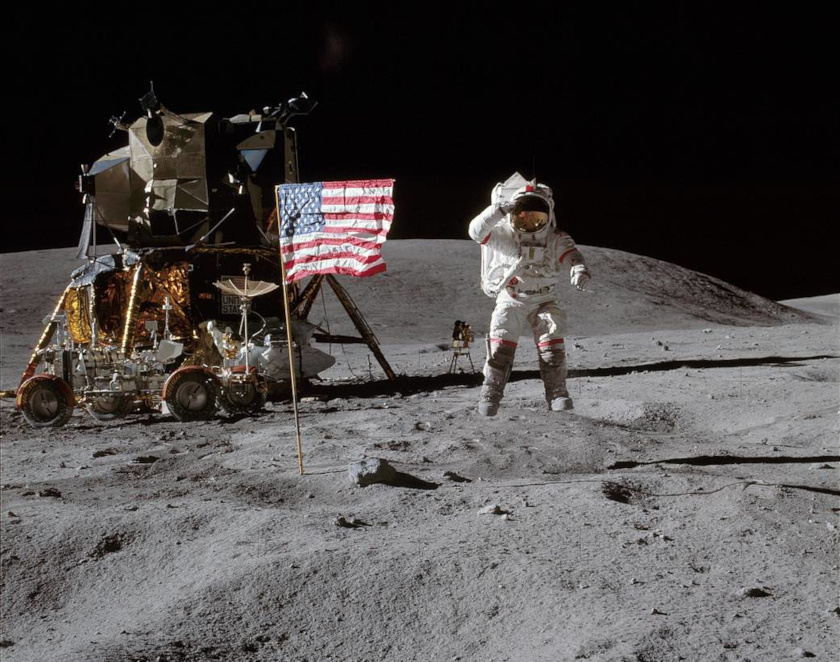
Picture: Charlie Duke/NASA (used by permission)
The zero gravity allowed you to have a bit of fun up there too. You did your own Moon Olympics.
Well, that was on the Moon. The one-sixth gravity on the Moon was really freeing. Down here, with all of my equipment on, I weighed 362 pounds, up on the Moon, I weighed 60 pounds. And so, you could jump high but easy to lose your balance. So we just thought it would be fun and have the Moon Olympics on the Moon, a high jump and a broad jump. It turned out that, during the high jump, I fell over backwards, which was the only scary moment of the whole mission. Fortunately, my suit held together and I bounced onto my back. But that ended the Olympics, it was really a frightening moment at that point as I was falling over backwards.
Tell us why. If something had have happened to your spacesuit, what would’ve happened?
Well, I wasn’t concern about the spacesuit actually, it was very strong. It’d been demonstrated to me that you could, you know, pound it with a sledgehammer and it was gonna hold together. The weak link was the backpack which was our life support system which contained oxygen, and electrical power, and cooling water, and communications, and it was cables, and electrical systems, and plumbing. And if you fell on your back on that, you could rupture a tank, you could rupture the plumbing, and you lose all your pressurisation and you die. The body can’t survive a vacuum. And so, the danger on the lunar surface, or out in space on a spacewalk, is if a glove pops off or a helmet breaks or something happens, you lose your pressurisation, there’s no way out, you’re dead.
The Many Risks Involved
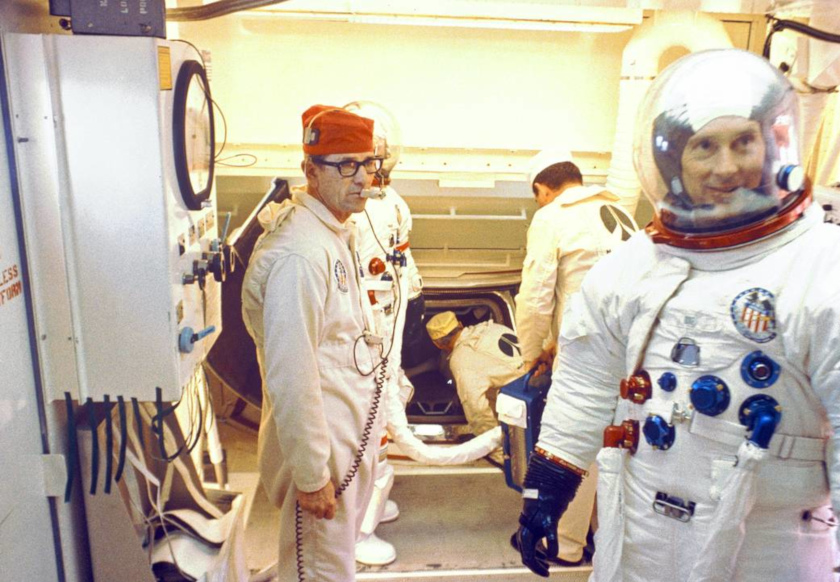
Picture: NASA (used by permission)
Tell us about some of those other small margins of error. What else could’ve gone wrong?
Well, of course in the final stages of landing, we could’ve had a computer problem that would’ve caused the jets to fire incorrectly. We could’ve had a short in some of the electrical systems which could lose pressurisation, you could lose your guidance system. There were a lot of little things that could happen that could kill you in the final stages of flight. And of course on liftoff from the Moon, if the engine didn’t light, and you couldn’t get it lit through the emergency procedures, you were just going to die. Sooner or later you would give out oxygen, probably just go to sleep from high concentrations of carbon dioxide.
It really was an amazing feat of humanity, wasn’t it?
It’s amazing, yeah. Looking back, you know, with what look like from now rudimentary technologies, but then, the state of the art. Our computer on board had 80K memory and, you know, your cell phone has lots more than that in miniaturisation and everything. But it all worked and we had motivated people, dedicated people, smart people involved in all stages of this program, and people didn’t make any mistakes. Except for Apollo 1, Apollo was a tremendous success, even recovering Apollo 13, which was a near disaster.
Approaching the Moon in the Lunar Module
So you’re in the Lunar Module and you’re approaching the Moon’s surface. You can see the craters starting to get closer through the window. How do you feel at that moment?
Very excited. Actually you don’t see the lunar surface until you are about 2 kilometres above the surface. And at that point, the vehicle makes a maneuver and the surface comes into view through the front window. And we recognised the major landmarks in our landing area and we knew we were almost directly on target and on track. And so, I began to look out the window to see about our traverse to the north, which we had thought was gonna be very rough terrain, turned out it looked okay, took a quick glance out for the west, that terrain looked okay. And then, of course we started concentrating mostly on getting us safe landing. So I talked John, John was actually flying, and I talked him down giving him information that he needed to make a safe landing. And we did.
Walking, and Buggy-Driving, on the Moon
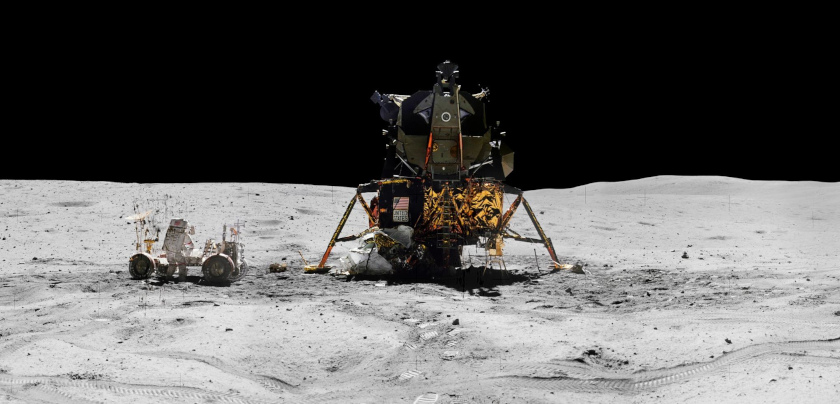
Picture: Charlie Duke/NASA (used by permission)
So Ken Mattingly is back in the commander ship. You and John Young then don the space suits and go for a moonwalk. Tell me what that’s like.
Well, of course, very very exciting. Emotionally, it was a great high, the culmination of all of our training and effort. And so, I opened the hatch, John got out, climbed down the ladder. And a few minutes later, I climbed down the ladder and, since we were the fifth landing, we knew we weren’t going to sink into the Moon dust, it was going to support our weight. So we just hopped off the pad and I was in awe of the beauty of the Moon, and the pristine nature of it, and the thoughts kept occurring, “Nobody has ever been here before.” You know, “Look at the mountains to the south and the mountains to the north, the grey rolling terrain and just the excitement of being there.” You know, it was like a kid, Christmas morning, running from one present to the next. And that’s really the way we did it, but more in an organised fashion because we had a lot to do and a lot to accomplish. So we were just in wonder and all as we were going about our business.
You did have some jobs to do like collecting moon rocks and things like that, didn’t you?
The primary objective of course was to collect the variety of rocks that we were to find in our landing area. But we also had a whole suite of experiments that we emplaced and left on the Moon. Two seismic experiments, a magnetometer, a mass heat flow, a mass spectrometer, those kind of things that would measure these parameters of the Moon, where we landed. And then, we had a lot of special geology experiments that we did.
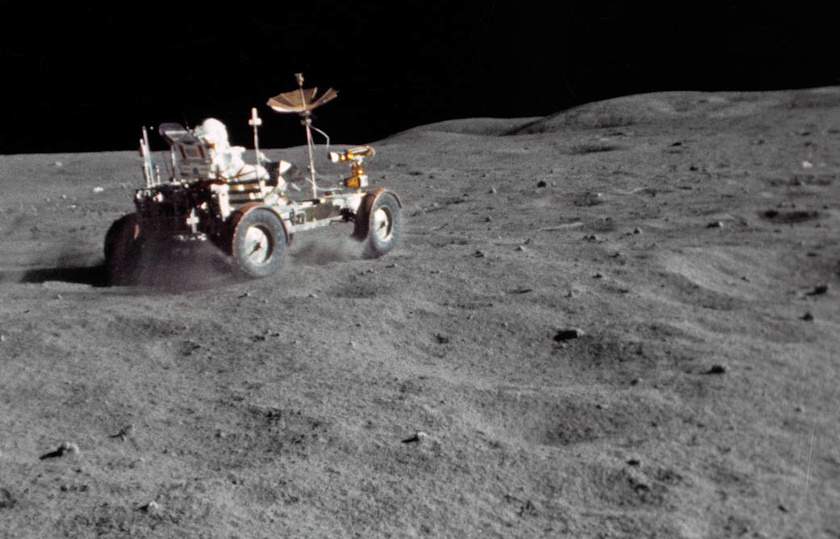 Picture: Charlie Duke/NASA (used by permission)
Picture: Charlie Duke/NASA (used by permission)
You also got to race around in that lunar buggy, if I’ve got the terminology correct. That looked like a lot of fun.
It was. It was called the Lunar Rover; we just called it the rover. I was the navigator and I sat in the right seat. John was the driver, he sat in the left seat. And so, I had a set of maps that would try to navigate us from point A to point B. The farthest we got was about 4 maybe 5 kilometers away from our landing spot. And it was rough driving across the Moon. This little car only weighed 80 pounds, it bounced a lot, you had to put on your seat belt. And it spun a lot, the back end, it was very sensitive steering so the back end would break loose and spin out a little bit. So it was a challenge driving it for John but also a lot of fun.
That’s still up there on the Moon, isn’t it?
Yes, the last three Apollo missions had a rover, so there are three. And as I say to folks, “If you want a $8,000,000 car with a dead battery, there’s three of them on the Moon.”
Did you bring back any personal mementos? Are there any moon rocks sitting on your shelves or any moon dust saved from your shoes?
Ah, I got the maps and the shovel that we used on the moon; some of our check lists that we were using; I stuck some little pins in my pocket that we pulled out of the experiments as we deployed them. But we weren’t allowed to keep any moon rocks or moon dust of any significance. I don’t have my moon boots either—we left those up there, which was a mistake. I wish I had brought them back.
Why did you leave them up there?
We only had a limited weight allowed so we could lift off the moon and the rocks were the majority of the pay load, plus us. There were very few pounds of extra material that we could bring back with us, so we kicked out the back packs and we left the moon boots up there. But the boots didn’t weigh very much so I wish I’d had them now as a memento, but I don’t.
A Three Day Journey Home

Picture: NASA (used by permission)
So, it’s time to go back home. You’ve kicked out the boots and the back packs and you get back to the commander vehicle. You’re then hurtling back to earth sitting in this hunk of steel…
It was another three day journey back and it was very relaxing for us because the mission was accomplished. The spacecraft was in good shape operationally and we had about a day where we got everything tied down and secure for the re-entry. Then we just got in position to re-enter, which was the last spectacular experience of the whole mission. As we hit the atmosphere at over 40,000 kilometres per hour, we had a fire ball around the spacecraft. It was like being inside a furnace. Outside it was very hot, but inside it was a very comfortable 70 degrees.
We were decelerating at 7.5 times gravity, so it felt like a big elephant was sitting on your chest for a while. That went away and then we started falling towards earth. The parachutes came out at about 8,000ft—3,000 metres or so—and we had a big splashdown in the Pacific Ocean. And then it was mission complete.
A Restless, ‘Driven’ Man
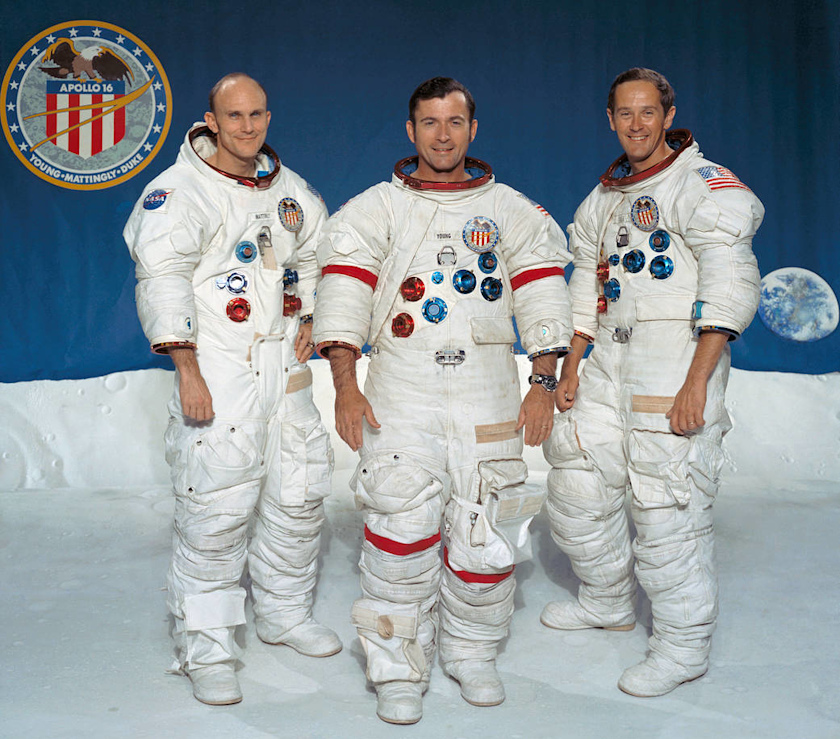
Picture: NASA (used by permission)
You’ve described yourself as pretty driven in those days – driven for success, driven in your career. But once you’ve walked on the Moon, what more is there left to achieve? Describe your emotional state after Apollo 16.
After Apollo 16 I was pumped up, as you can imagine, having just experienced this great adventure. And I wanted to go again, so I volunteered for a backup crew for Apollo 17 for the outside chance of maybe going to the Moon again. Well, didn’t work. They stayed healthy and the primary crew flew. And after that was over, it was January of 1973, so it was like 9 months later after we flew and now Apollo was over. And the thought did occur to me, “Okay, now what are you gonna do with the rest of your life? You’re 37-years-old, you’ve had this great experience, you’ve climbed the top of the ladder. How are you gonna top this, buddy?” I began to look around trying to find what was satisfying. I’ve worked on Space Shuttle, it was exciting but not as thrilling as Apollo. I took my eyes off the Moon and put them on money, making a business and making a lot of money would satisfy this drive that I still had.
You see, in my heart, that drive that took me to the Moon was still there. And while I was satisfied for a while now, I was still motivated to do something, to bring this peace and satisfaction and purpose to my life. But business didn’t do it. It was only later on, about 6 years later, when I really found out the answer that I was searching for.
While you wondering what you were going to do with your life, Dotty, your wife, was going through her own dark valley, with depression and even suicidal feelings.
Yes. And that was a real shock to me. We had been married 9 years, when I went to the Moon, and then, the ensuing 3 years after that was very tough on Dotty. She thought that, when the Moon flights were over, we could work on our marriage because it was under a lot of stress and strain at that point, me gone all the time, training, anxious, she’s anxious about my safety, etc., two little kids to raise. So there was a lot of stress on her life and she wanted to work on her marriage, after where I got back, but it turned out that I was still driven. And she was saying, “Well, I’ll never have a happy marriage,” and so, she tried a number of things to find her direction. But nothing worked for her until some people came to our church in October, 1975, on what was called a Faithful Life Weekend.
And these people had a personal relationship with Jesus and they had a peace and a joy and a purpose in their life. And they said Jesus brought it to them and they related their stories, some similar to what Dotty’s was going through, and how they had experienced a transformation. So, after that weekend, she prayed, “God, I don’t know whether you’re real,” and, “Jesus, I don’t know whether you’re the Son of God, but if you are, give me my life. If you’re not, I wanna die.”
Transformed by Faith
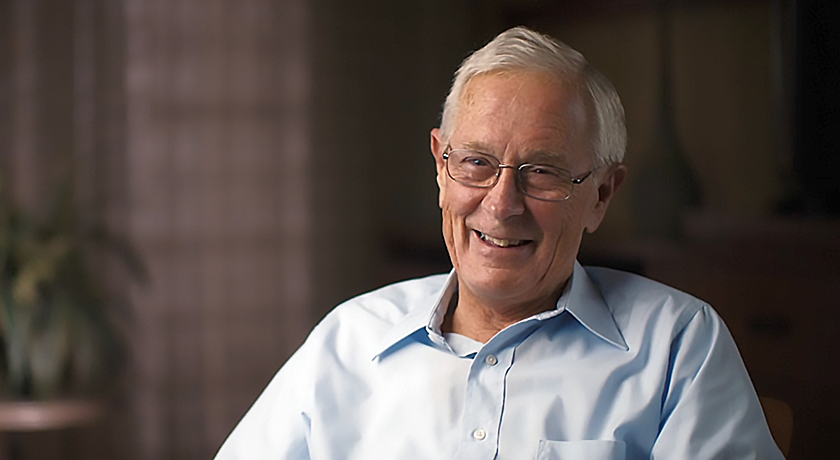
Picture: Mission Control
Well there really is a God, and Jesus came into her life and I watched her change from sadness to joy over the next 3 to 4 months and things really started getting better at home. But I was in business, at this point, and not really interested in a deeper walk with God. I believed in God, you know, I’d been Baptised and I went to church faithfully and all of that but it was more of a mental acknowledgement of God than rather a heartfelt understanding and knowing God.
So Dotty, over the next 2 and a half years, she just began to change and love me, and our home began to have a peace in it. And after I sold this business, finding out money wasn’t the answer, we were invited to a Bible study at a tennis club, one weekend, in April of 1978. And at that point of my life, I realised that I had to make a decision that Jesus was really the Son of God, or the biggest liar that ever walked, and scriptures that I’d learned in Sunday school years ago began to come back. And it was, “Is this true or is it not true? It’s either true or it isn’t. There’s no maybe, you know, there’s no riding a fence. And Jesus is either who he says he is, who died for our sins that we might have eternal life or he’s a big liar. We get to make up our minds. We have free will. We can receive it, believe it, accept it in a heartfelt way, and our life will be transformed by His power. And we can walk with God or we can turn away and say, ‘I don’t need any of this,’ and enter eternity without God.” It’s amazing how God loves us but he doesn’t make us robots and we can choose to be obedient, and follow, and experience the joy, and the love, and the piece of God. And that’s what happened in my life when I said, “Yes, Lord.”
Even the Moon Won’t Fulfil a Restless Soul
The thing I find amazing about your story, Charlie, is that you can travel to the Moon and back and still be spiritually empty.
Right. You know, it wasn’t a spiritual experience for me going to the Moon. I didn’t feel close to God or feel like searching for God any more than I had, which was church and Sunday acknowledgement of God, but no seeking him, no desire to serve Him. But I realised that what was really my God in those days was my career. I’d put career first in my life. And career is not God, money is not God, sex is not God, idols are not God. You know, there’s only one God, His name is Jesus, and if you put anything else above Him in your life, you’re gonna be empty. Sooner or later, you’re gonna end up disappointed.
The walk on the Moon was fantastic, but it lasted 3 days, required a lot of money and a lot of training. The walk with Jesus is free, He paid the price, and it lasts forever.
Learn More
Open House Volume 3 has the full transcript
Talk to Me
Leave a comment below now or call me using the ‘Send Voicemail’ button on the right. Please also rate and share this podcast on iTunes to help others discover it!
Subscribe
Subscribe to More Than This and never miss an episode.
| |
Subscribe in iTunes |
| |
Subscribe on your iPad or smartphone |
| |
Subscribe in Stitcher |


